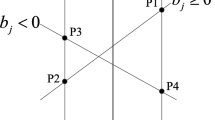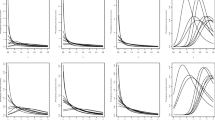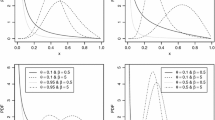Abstract
The topic of this paper is the solution of reliability problems where failure is influenced by the spatial random fluctuations of loads and material properties. Homogeneous random fields are used to model this kind of uncertainty. The first step of the investigation is the random field discretization, which transforms a random field into a finite set of random variables. The second step is the reliability analysis, which is performed using the FORM in this paper. A parametric analysis of the reliability index is usually performed with respect to the random field discretization accuracy. This approach requires several independent reliability analyses. A new and efficient approach is proposed in this paper. The Karhunen–Loève series expansion is combined with the FEM for the discretization of the random fields. An efficient solution of the reliability problem is proposed to predict the reliability index as the discretization accuracy increases.














Similar content being viewed by others
References
Lemaire M (2009) Structural reliability. Wiley, New York
Liu PL, Der Kiureghian A (1991) Optimization algorithms for structural reliability. Struct Saf 9:161–177
Allaix DL, Carbone VI (2011) An improvement of the response surface method. Struct Saf 33:165–172
Allaix DL, Carbone VI, Mancini G (2011) Advanced response surface method for structural reliability. Paper presented at the 13th International Conference on Civil, Structural and Environmental Engineering Computing, Chania, Greece
Basaga B, Bayraktar A, Kaymaz I (2012) An improved response surface method for reliability analysis of structures. Struct Eng Mech 42(2):175–189
Bucher CG, Bourgund U (1990) A fast and efficient response surface approach for structural reliability problems. Struct Saf 7:57–66
Kim SH, Na SW (1997) Response surface method using vector projected sampling points. Struct Saf 19:3–19
Rajashekhar MR, Ellingwood BR (1993) A new look at the response surface approach for reliability analysis. Struct Saf 12:205–220
Hasofer AM, Lind NC (1974) Exact and invariant second-moment code format. J Eng Mech Div ASCE 100:111–121
Li Y, Vrouwenvelder T, Wijnants GH, Walraven J (2004) Spatial variability of concrete deterioration and repair strategies. Struct Concr 3:121–129
Defaux G, Pendola M, Sudret B (2006) Using spatial reliability in the probabilistic study of concrete structures: the example of a RC beam subject to carbonation inducing corrosion. J Phys 136:243–253
Stewart MG, Mullard JA (2007) Spatial time-dependent reliability analysis of corrosion damage and the timing of first repair for RC structures. Eng Struct 29:1457–1464
Allaix DL, Carbone VI, Mancini G (2011) Random fields for the modeling of deteriorated structures. Paper presented at the 11th International Conference on Applications of Statistics and Probability in Civil Engineering, Zurich, Switzerland
Vanmarcke E (1983) Random fields, analysis and synthesis. The MIT Press, Cambridge
Brenner C, Bucher C (1995) A contribution to the SFE-based reliability assessment of non linear structures under dynamic loading. Probab Eng Mech 107:449–463
Der Kiureghian A, Ke JB (1988) The stochastic finite element method in structural reliability. Probab Eng Mech 3(2):83–91
Ghanem RG, Spanos PD (1991) Stochastic finite elements: a spectral approach. Springer, New York
Li CC, Der Kiureghian A (1993) Optimal discretization of random fields. J Eng Mech 119:1136–1154
Mahadevan S, Haldar A (1991) Practical random field discretization in stochastic finite element analysis. Struct Saf 9:283–304
Matthies HG, Brenner CE, Bucher CG, Guedes Soares C (1997) Uncertainties in probabilistic analysis of structures and solids-stochastic finite elements. Struct Saf 19:283–336
Sudret B, Der Kiureghian A (2000) Stochastic finite elements and reliability: a state-of-the-art report. Technical Report UCB/SEMM-2000/08, University of California, Berkeley, USA
Vanmarcke E, Grigoriu M (1983) Stochastic finite element analysis of simple beams. J Eng Mech 109:1203–1214
Vanmarcke E, Shinozuka M, Nakagiri S, Schueller GI, Grigoriu M (1986) Random fields and stochastic finite elements. Struct Saf 3:143–166
Allaix DL, Carbone VI (2008) Adaptive discretization of 1D homogeneous random fields. Paper presented at the Joint ESREL and SRA-Europe Conference, Valencia, Spain
Allaix DL, Carbone VI (2010) Numerical discretization of stationary random processes. Probab Eng Mech 25:332–347
Liu PL, Liu KG (1993) Selection of random field mesh in finite element reliability analysis. J Eng Mech 119:667–679
Maymon G (1994) Direct computation of the design point of a stochastic structure using a finite element code. Struct Saf 14:185–202
Zhang J, Ellingwood B (1994) Orthogonal series expansion of random fields in reliability analysis. J Eng Mech 120(12):2660–2677
Ngah MF, Young A (2007) Application of the spectral stochastic finite element method for performance prediction of composite structures. Compos Struct 78:447–456
Sudret B, Der Kiureghian A (2002) Comparison of finite element reliability methods. Probab Eng Mech 17:337–348
Stefanou G (2009) The stochastic finite element method: past, present and future. Comput Method Appl Mech Eng 198:1031–1051
Huang SP, Quek ST, Phoon KK (2001) Convergence of the truncated Karhunen–Loeve expansion for simulation of stochastic processes. Int J Numer Methods Eng 52:1029–1043
Li LB, Phoon KK, Quek ST (2007) Comparison between Karhunen–Loève expansion and translation-based simulation of non-Gaussian processes. Comput Struct 85:264–276
Phoon KK, Huang HW, Quek ST (2005) Simulation of strongly non-Gaussian processes using Karhunen–Loeve expansion. Probab Eng Mech 20:188–198
Betz W, Papaioannou I, Straub D (2014) Numerical methods for the discretization of random fields by means of the Karhunen–Loeve expansion. Comput Methods Appl Mech Eng 271:109–129
Phoon KK, Huang SP, Quek ST (2002) Simulation of second order processes using Karhunen–Loève expansion. Comput Struct 80:1049–1060
Allaix DL, Carbone VI (2012) Development of a numerical tool for random field discretization. Adv Eng Softw 51:10–19
Haldar A, Mahadevan S (2000) Probability, reliability, and statistical methods in engineering design. Wiley, New York
Koduru SD, Haukaas T (2010) Feasibility of FORM in finite element reliability analysis. Struct Saf 32:145–153
Rackwitz R (2001) Reliability analysis—a review and some perspectives. Struct Saf 23:365–395
Valdebenito MA, Pradlwarter HJ, Schuëller GI (2010) The role of the design point for calculating failure probabilities in view of dimensionality and structural nonlinearities. Struct Saf 51:101–111
Waarts PH, Vrouwenvelder ACWM (1999) Stochastic finite analysis of steel structures. J Constr Steel Res 52:21–32
Haukaas T, Scott MH (2006) Shape sensitivities in the reliability analysis of non-linear frame structures. Comput Struct 84:964–977
Charmpis DC, Schuëller GI, Pellissetti MF (2007) The need for linking micromechanics of materials with stochastic finite elements: a challenge for materials science. Comput Mater Sci 41:27–37
Deodatis G (1991) Weighted integral method. I: stochastic stiffness matrix. J Eng Mech 117:1851–1884
Chowdhury RN, Xu DW (1992) Reliability index for slope stability assessment—two methods compared. Reliab Eng Syst Saf 37:99–108
Author information
Authors and Affiliations
Corresponding author
Rights and permissions
About this article
Cite this article
Allaix, D.L., Carbone, V.I. An efficient coupling of FORM and Karhunen–Loève series expansion. Engineering with Computers 32, 1–13 (2016). https://doi.org/10.1007/s00366-015-0394-1
Received:
Accepted:
Published:
Issue Date:
DOI: https://doi.org/10.1007/s00366-015-0394-1




